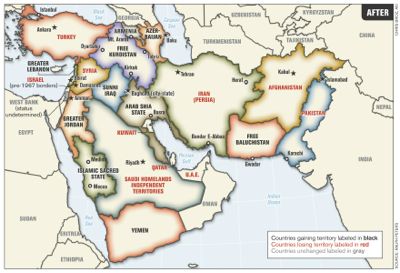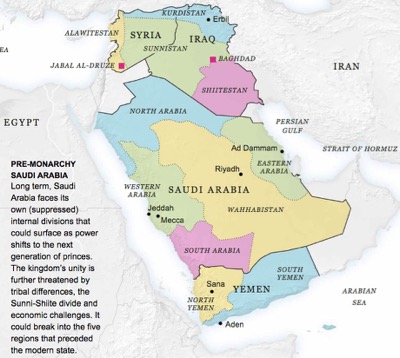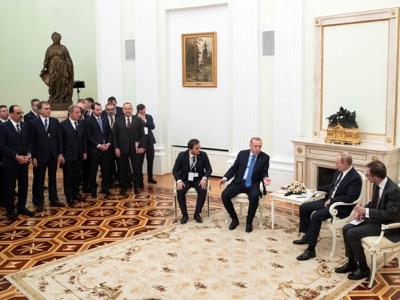Which target after Syria?

Events in the “Broader Middle East” since 2001 have followed a relentless logic. The current question is whether the time has come for a new war in Turkey or Saudi Arabia. The answer depends in particular on the resumption of hostilities in Libya. It is in this context that the Additional Protocol negotiated by Presidents Erdoğan and Putin to resolve the Idleb crisis must be interpreted.
19 years of “war without end”
President George W. Bush decided to radically transform the Pentagon’s missions, as Colonel Ralph Peters explained in the Army magazine Parameters on September 13, 2001. Secretary of Defense Donald Rumsfeld appointed Admiral Arthur Cebrowski to train future officers. Cebrowski spent three years touring military universities so that today all general officers have taken his courses. His thoughts were popularized for the general public by his deputy, Thomas Barnett.
The areas affected by the US war will be given over to “chaos”. This concept is to be understood in the sense of the English philosopher Thomas Hobbes, i.e. as the absence of political structures capable of protecting citizens from their own violence (“Man is a wolf to man”). And not in the biblical sense of making a clean slate before the creation of a new order.
This war is an adaptation of the US Armed Forces to the era of globalization, to the transition from productive capitalism to financial capitalism. “War is a Racket,” as Smedley Butler, America’s most decorated general, used to say before World War II [1]. From now on, friends and enemies will no longer count; war will allow for the simple management of natural resources.
This form of war involves many crimes against humanity (including ethnic cleansing) that the US Armed Forces cannot commit. Secretary Donald Rumsfeld therefore hired private armies (including Blackwater) and developed terrorist organizations while pretending to fight them.
The Bush and Obama administrations followed this strategy: to destroy the state structures of entire regions of the world. The US war is no longer about winning, but about lasting (the “war without end”). President Donald Trump and his first National Security Advisor, General Michael Flynn, have questioned this development without being able to change it. Today, the Rumsfeld/Cebrowski thinkers pursue their goals not so much through the Defence Secretariat as through NATO.
After President Bush launched the “never-ending war” in Afghanistan (2001) and Iraq (2003), there was strong contestation among Washington’s political elites about the arguments that had justified the invasion of Iraq and the disorder there. This was the Baker-Hamilton Commission (2006). The war never stopped in Afghanistan or Iraq, but it took five years for President Obama to open new theatres of operation: Libya (2011), Syria (2012) and Yemen (2015).
Two external actors interfered with this plan.
![]() In 2010-11, the United Kingdom launched the “Arab Spring”, an operation modeled on the “Arab Revolt” of 1915, which allowed Lawrence of Arabia to put the Wahhabi in power on the Arabian Peninsula. This time it was a question of placing the Muslim Brotherhood in power with the help not of the Pentagon, but of the US State Department and NATO.
In 2010-11, the United Kingdom launched the “Arab Spring”, an operation modeled on the “Arab Revolt” of 1915, which allowed Lawrence of Arabia to put the Wahhabi in power on the Arabian Peninsula. This time it was a question of placing the Muslim Brotherhood in power with the help not of the Pentagon, but of the US State Department and NATO.
![]() In 2014, Russia intervened in Syria, whose state had not collapsed and which it helped to resist. Since then, the British – who had tried to change the regime there during the “Arab Spring” (2011-early 2012) – and then the Americans – who were seeking to overthrow not the regime, but the state (mid-2012 to the present) – have had to withdraw. Russia, pursuing the dream of Tsarina Catherine, is today fighting against chaos, for stability – that is to say, for the defence of state structures and respect for borders.
In 2014, Russia intervened in Syria, whose state had not collapsed and which it helped to resist. Since then, the British – who had tried to change the regime there during the “Arab Spring” (2011-early 2012) – and then the Americans – who were seeking to overthrow not the regime, but the state (mid-2012 to the present) – have had to withdraw. Russia, pursuing the dream of Tsarina Catherine, is today fighting against chaos, for stability – that is to say, for the defence of state structures and respect for borders.
Colonel Ralph Peters, who in 2001 revealed the Pentagon’s new strategy, published Admiral Cebrowski’s map of objectives in 2006. It showed that only Israel and Jordan would not be affected. All other countries in the “Broader Middle East” (i.e., from Morocco to Pakistan) would gradually be stateless and all major countries (including Saudi Arabia and Turkey) would disappear.
Noting that its best ally, the United States, was planning to cut its territory in two in order to create a “free Kurdistan”, Turkey unsuccessfully tried to get closer to China, and then adopted the theory of Professor Ahmet Davutoğlu: “Zero problems with its neighbours”. It distanced itself from Israel and began to negotiate peace with Cyprus, Greece, Armenia, Iraq etc. It also distanced itself from Israel. Despite the territorial dispute over Hatay, it created a common market with Syria. However, in 2011, when Libya was already isolated, France convinced Turkey that it could escape partition if it joined NATO’s ambitions. President Recep Tayyip Erdoğan, a political Islamist of the Millî Görüş, joined the Muslim Brotherhood, of which he was not a member, hoping to recoup the fruits of the ’Arab Spring’ for his own benefit. Turkey turned against one of its main clients, Libya, and then against one of its main partners, Syria.
In 2013, the Pentagon adapted the “endless war” to the realities on the ground. Robin Wright published two corrective maps in the New York Times. The first dealt with the division of Libya, the second with the creation of a “Kurdistan” affecting only Syria and Iraq and sparing the eastern half of Turkey and Iran. It also announced the creation of a “Sunnistan” straddling Iraq and Syria, dividing Saudi Arabia into five and Yemen into two. This last operation began in 2015.
The Turkish General Staff was very happy with this correction and prepared for the events. It concluded agreements with Qatar (2017), Kuwait (2018) and Sudan (2017) to set up military bases and surround the Saudi kingdom. In 2019 it financed an international press campaign against the “Sultan” and a coup d’état in Sudan. At the same time, Turkey supported the new project of “Kurdistan” sparing its territory and participated in the creation of “Sunnistan” by Daesh under the name of “Caliphate”. However, the Russian intervention in Syria and the Iranian intervention in Iraq brought this project to a halt.
In 2017, regional president Massoud Barzani organised a referendum for independence in Iraqi Kurdistan. Immediately, Iraq, Syria, Turkey and Iran understood that the Pentagon, returning to its original plan, was preparing to create a “free Kurdistan” by cutting up their respective territories. They coalesced to defeat it. In 2019, the PKK/PYG announced that it was preparing for the independence of the Syrian ’Rojava’. Without waiting, Iraq, Syria, Turkey and Iran once again joined forces. Turkey invaded the “Rojava”, chasing the PKK/YPG, without much reaction from the Syrian and Russian armies.
In 2019, the Turkish General Staff became convinced that the Pentagon, having temporarily renounced destroying Syria because of the Russian presence, was now preparing to destroy the Turkish state. In order to postpone the deadline, it tried to reactivate the “endless war” in Libya, then to threaten the members of NATO with the worst calamities: the European Union with migratory subversion and the United States with a war with Russia. To do this, it opened its border with Greece to migrants and attacked the Russian and Syrian armies in Idleb where they bombed the Al Qaeda and Daesh jihadists who had taken refuge there. This is the episode we are living through today.

- Robin Wright’s “Reshaping the Broader Middle East” map, published by Robin Wright.
The Moscow Additional Protocol
The Turkish army caused Russian and Syrian casualties in February 2020, while President Erdoğan made numerous phone calls to his Russian counterpart, Putin, to lower the tension he was causing with one hand.
US Secretary of State Mike Pompeo pledged to curb the Pentagon’s appetites if Turkey helped the Pentagon restart the “endless war” in Libya. This country is divided into a thousand tribes that clash around two main leaders, both CIA agents, the president of the Presidential Council, Fayez el-Sarraj, and the commander of the National Army, Khalifa Haftar.
Last week, the UN Secretary General’s special envoy to Libya, Professor Ghassan Salame, was asked to resign for “health reasons”. He complied, not without expressing his bad mood at a press conference. An axis has been set up to support al-Sarraj by the Muslim Brotherhood around Qatar and Turkey. A second coalition was born around Haftar with Egypt and the United Arab Emirates, but also Saudi Arabia and Syria.
It is the great return of the latter on the international scene. Syria is the culmination of nine years of victorious resistance to the Brotherhood and the United States. Two Libyan and Syrian embassies were opened with great pomp and circumstance on 4 March, in Damascus and Benghazi.
Moreover, the European Union, after having solemnly condemned the “Turkish blackmail of refugees”, sent the President of the Commission to observe the flow of refugees at the Greek-Turkish border and the President of the Council to survey President Erdoğan in Ankara. The latter confirmed that an arrangement was possible if the Union undertook to defend the ’territorial integrity’ of Turkey.

- With keen pleasure, the Kremlin has staged the surrender of Turkey: the Turkish delegation is standing, contrary to the habit where chairs are provided for guests; behind it, a statue of Empress Catherine the Great recalls that Russia was already present in Syria in the 18th century. Finally, Presidents Erdoğan and Putin are seated in front of a pendulum commemorating the Russian victory over the Ottoman Empire.
It was thus on this basis that President Vladimir Putin received President Recep Tayyip Erdoğan in the Kremlin on March 5. A first, restricted, three-hour meeting was devoted to relations with the United States. Russia would have committed itself to protect Turkey from a possible partition on the condition that it signs and applies an Additional Protocol to the Memorandum on Stabilization of the Situation in the Idlib De-Escalation Area [2]. A second meeting, also of three hours duration but open to ministers and advisers, was devoted to the drafting of this text. It provides for the creation of a 12-kilometre-wide security corridor around the M4 motorway, jointly monitored by the two parties. To put it plainly: Turkey is backing away north of the reopened motorway and losing the town of Jisr-el-Chogour, a stronghold of the jihadists. Above all, it must at last apply the Sochi memorandum, which provides for support only for the Syrian armed opposition, which is supposed to be democratic and not Islamist, and for combating the jihadists. However, this “democratic armed opposition” is nothing more than a chimera imagined by British propaganda. In fact, Turkey will either have to kill the jihadists itself, or continue and complete their transfer from Idleb (Syria) to Djerba (Tunisia) and then Tripoli (Libya) as it began to do in January.
In addition, on March 7, President Putin contacted former President Nazerbayev to explore with him the possibility of deploying Kazakh “blue chapkas” in Syria under the auspices of the Collective Security Treaty Organization (CSTO). This option had already been considered in 2012. Kazakh soldiers have the advantage of being Muslims and not orthodox.
The option of attacking Saudi Arabia rather than Turkey from now on has been activated by the Pentagon, it is believed to be known in Riyadh, although President Trump is imposing delirious arms orders on it in exchange for its protection. The dissection of Saudi Arabia had been envisaged by the Pentagon as early as 2002 [3].
Missiles were fired this week against the royal palace in Riyadh. Prince Mohamed ben Salmane (known as “MBS”, 34 years old) had his uncle, Prince Ahmed (70 years old), and his former competitor and ex-heir prince, Prince Mohamed ben Nayef (60 years old), as well as various other princes and generals arrested. The Shia province of Qatif, where several cities have already been razed to the ground, has been isolated. Official explanations of succession disputes and coronavirus are not enough [4].
 TheAltWorld
TheAltWorld 
0 thoughts on “Which target after Syria?”